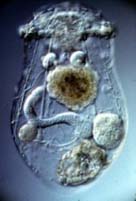Scientists discover the smallest animals in the sea - zooplankton
Zooplankton are the smallest animals in the sea and a vital link in marine life, yet scientists know next to nothing about them.

A deep-sea trawl by scientists has come up with hundreds of species of zooplankton - from tiny shrimp-like creatures and swimming worms to flying snails and pulsing jellyfish.
In the Sargasso Sea of the North Atlantic they catalogued about 500 species of zooplankton living at depths of between 800m to 4.5km.
Their investigation was designed to capture some of the most important, but overlooked, creatures of the oceans that play a vital role in both the food chain and the carbon cycle, reports New Zealand Herald.
Census of Marine Life scientists trawled rarely explored tropical ocean depths between the southeast US coast and the Mid-Atlantic Ridge to inventory and photograph the variety and abundance of zooplankton – small sea "bugs" that form a vital link in the ocean food chain – and other life forms.
Though relatively few in number compared with the uppermost ocean layer, scientists were amazed by the variety of tiny animals found at depths of 1 to 5 km (0.6 to 3 miles). Among thousands captured, 500 species have been catalogued, 220 of them DNA sequenced at sea revealing a number of new species.
The 20-day cruise, completed April 30, is part of an ambitious global inventory of zooplankton by 2010 (dubbed the Census of Marine Zooplankton, CMarZ), a Census of Marine Life initiative that sheds life on some important global ecosystem processes, including the ocean's function as Earth's largest carbon sink and the impact ocean acidification may have on life in the seas.
While helping moderate climate, zooplankton species also provide a fundamental link in the food chain between ocean plant life and predators from fish to whales, informs mongabay.
The zooplankton then carry the carbon from the surface to the depths, effectively sequestering it from the atmosphere, where it acts as a greenhouse gas.
The tiny creatures also help feed humans.
Here's a rough idea of how researchers think the food chain works:
Some 10,000 pounds of phytoplankton is consumed by 1,000 pounds of zooplankton, which in turn support 100 pounds of larger zooplankton, which become meals for 10 pounds of small fish species like herring or anchovies, which support 1 pound of a larger fish species that might end up on your dinner table.
Some birds and whales eat zooplankton, too.
"By 2010, the research conducted by this project will provide a baseline against which future generations can measure changes to the zooplankton and their provinces, caused by pollution, over-fishing, climate change and other shifting environmental conditions," Bucklin said, reports FOX News.
O.Ch.Subscribe to Pravda.Ru Telegram channel, Facebook, RSS!



